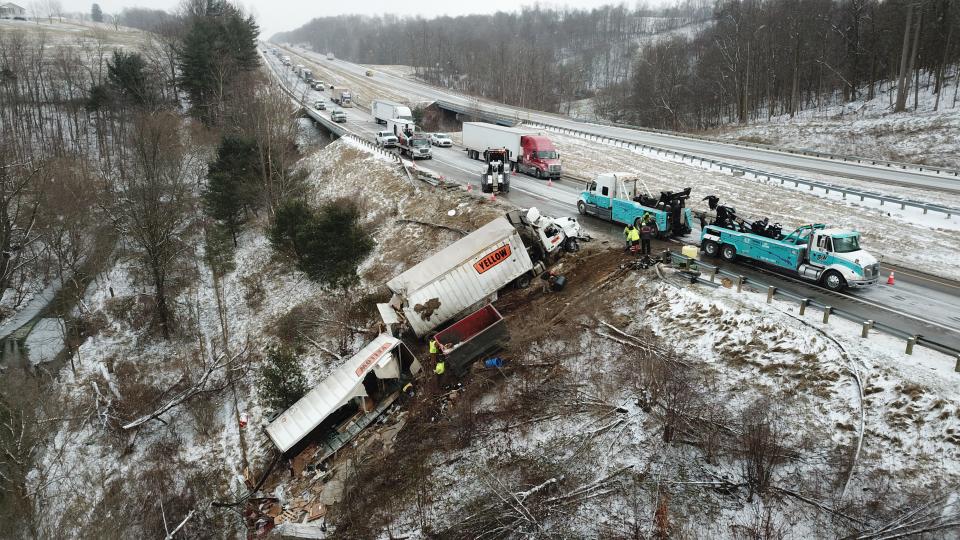Inflation hitting wallets of Ohio's drivers, homeowners

Add insuring your home and car to the list of expenses that cost more these days.
The price of auto insurance rose 0.9% in November alone and is now up 13.4% over the past year, according to the federal government's latest report on inflation released Dec. 12. The good news, if there is any, is that the 0.9% increase was down from 1.7% and 1.6% the prior two months.
In Ohio, the price of an average annual homeowner policy increased 10.6% to $1,004, Policygenius, an online insurance marketplace, said in a report in July. It found that from May 2021 to May 2022, 90% of homeowners say their quoted premium was higher than the year before. The average increase was $134.
While driving has yet to return to the levels it was before the pandemic started, accidents have started to climb again and fatal accidents in Ohio are at 20-year highs, according to the report. Speeding, drunken driving, distracted driving and unbelted drivers have been running at levels higher than before the pandemic.
"Nearly every sector of the U.S. economy has felt the effects of rising inflation, and the housing industry is no exception," said Pat Howard, a licensed property and casualty insurance expert at Policygenius. "Ongoing supply-chain issues, labor shortages and an uptick in billion-dollar natural disasters has caused the price of construction materials to skyrocket over the last two years. Because home insurance coverage amounts are primarily influenced by the cost to rebuild, this has led to an inflationary chain reaction that’s resulted in higher premium."
"The entire (insurance) industry is facing headwinds like inflation, supply-chain challenges and potential recession," said Beth Riczko, president of Nationwide's property and casualty personal lines.
For autos, new cars cost more as has the cost of fixing them. Prices of used cars have come down but continue to remain elevated.
"These factors are putting pressure on all insurers to make sure they maintain the necessary capital to meet the needs of their customers," Riczko said.
Before inflation, costs for Ohio drivers, homeowners had been stable
The jump in prices for auto and home insurance comes after several years of mostly small increases for Ohio consumers.
In 2021, homeowner rates among the top 10 insurers, which control three-quarters of Ohio's market, went up on average 1.1%, according to Ohio Department of Insurance data.
Nationwide, the No. 4 homeowner insurer, posted the biggest increase of the large insurers — 6.7% in 2021.
The 1.1% increase marked the third straight year of small rate increases after several years of mostly bigger increases, including 10.4% in 2012 and 11.2% in 2013.
Auto rates among the top 10, which control 80% of the Ohio market, declined in 2019 and 2020 but rose 2.7% in 2021, led by a 7.5% increase by Liberty Mutual, the No. 5 insurer in the state.
The average auto policy costs $1,034 in Ohio, according to a Bankrate study that found Ohio to be among the lowest states for the cost of an auto policy. Nationally, the average price is $1,771.
In Columbus, drivers pay $1,331 on average.
What is driving homeowner increase?
The costs of insuring a home are primarily based on how much it costs to rebuild a house.
"As construction costs continue to skyrocket due to delayed shipments and labor shortages, so, too, do home replacement costs," Howard said. "And this has a significant impact on homeowners insurance premiums."
Increasingly violent natural disasters also have helped push up premiums in some parts of the country as insurers anticipate losses and pass some of those costs onto policyholders.
The good news is projections are showing that reconstruction costs are starting to ebb, Howard said.
"However, these are just projections, and there’s no real way of knowing when home insurance prices will begin to ease up," he said.
How to save money on auto, homeowner insurance bills
Consumers should shop around at least once a year to make sure they are getting the best policies at the right price, Policygenius advises.
Policygenius also advises consumers to check with their insurance company to see if there are additional discounts that they might not have been eligible for in the past. Adding a security system or putting on a new roof could make them eligible for a discount or a credit.
Bundling policies or raising deductibles are other ways to save money.
Bundling home and auto policies can provide discounts of up to 30%, according to Policygenius' Howard, who also warns that although raising deductibles could save money, it also would mean more money out-of-pocket if they have to file a claim.
Some insurers will give discounts for customers who received documents digitally, pay premiums in full at one time, install devices in their home that detect such things as water leaks and for certain home improvements, such as renovating plumbing, cooling and electrical or replacing the roof, according to Nationwide.
One other risk for homeowners these days is not having enough coverage to match rising home values, according to Nationwide.
For example, a home that might have cost to $300,000 to rebuild a couple of years ago might cost $350,000 today. That leave consumers vulnerable in the event of a loss.
Recent data has shown that two in three homes are estimated to be underinsured by an average of 27%, according to Nationwide.
For drivers, usage-based insurance programs based on how much or how safe drivers are behind the wheel can lower auto insurance costs, according to Nationwide.
Nationwide’s SmartRide program has been in the market 10 years, offering drivers an average 25% discount based on their driving behavior. For those who are driving less, according to Nationwide, its SmartMiles program offers an average 34% discount compared with a traditional policy.
mawilliams@dispatch.com
@BizMarkWilliams
This article originally appeared on The Columbus Dispatch: How to minimize the hit from rising auto, home insurance rates
